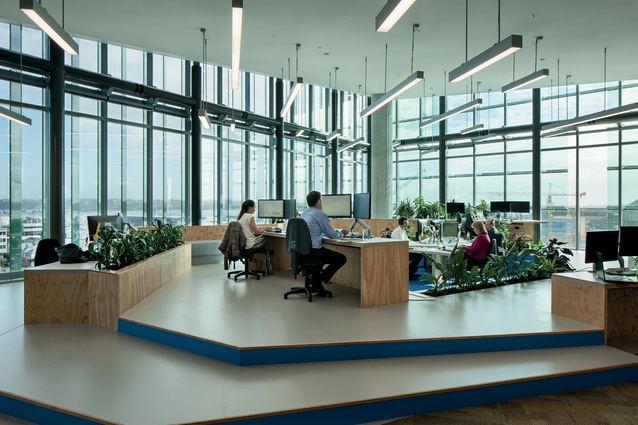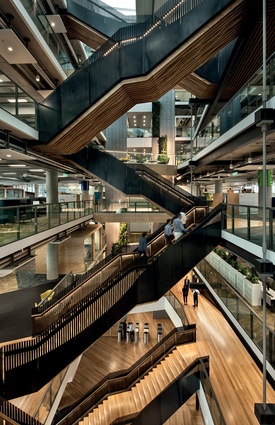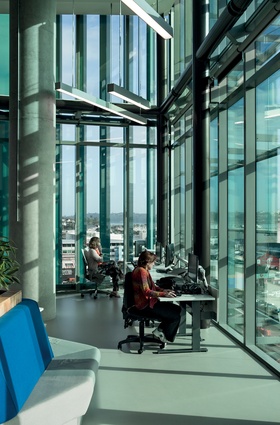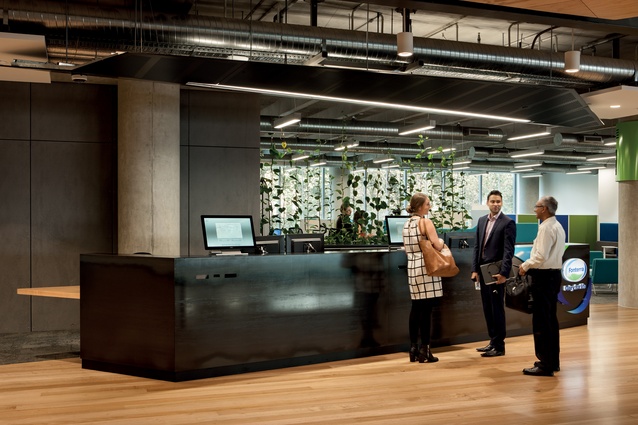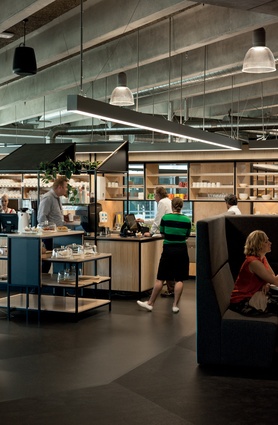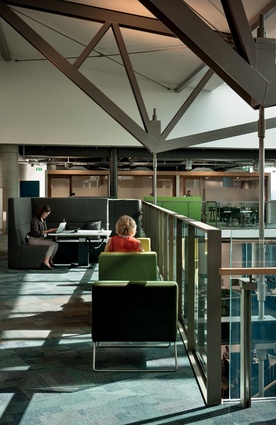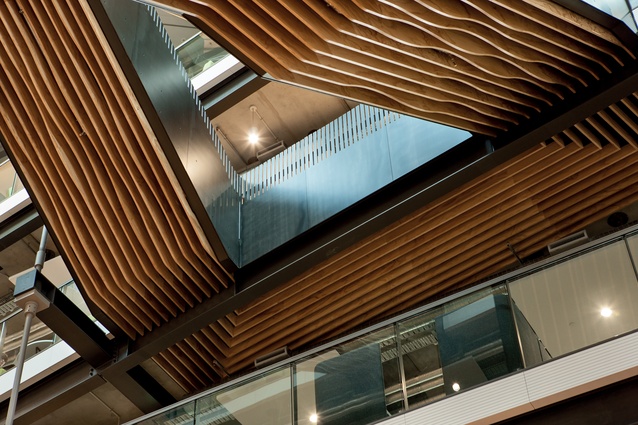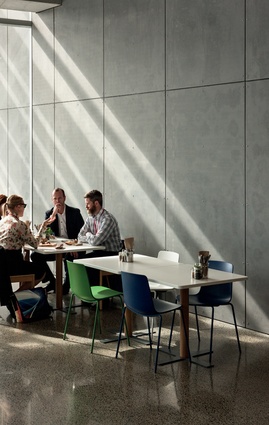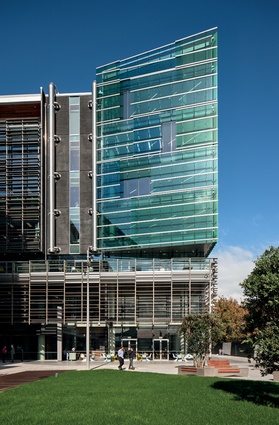Walking the talk
Fonterra Headquarters: The multinational dairy cooperative adopts activity-based working practices with the creation of its clean, green, new corporate base in downtown Auckland.
Fonterra is a company wholly owned by hard-working shareholders, most of whom head out to work each morning in gumboots. So, when creating a new headquarters in downtown Auckland, a considered approach was required to provide for the changing needs of the company without losing touch with its rural roots.
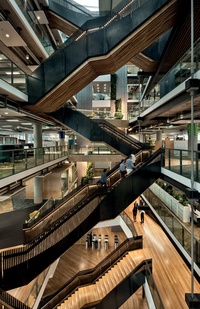
The creation of the new headquarters was driven by Fonterra’s need to amalgamate its corporate staff, who were scattered across five distinct Auckland locations, into “one Fonterra, if you will”, says Ben Coleman, Fonterra’s development manager, about the build. “There was a number of reasons for wanting to bring everyone together, including sustainability and cost effectiveness, but also the fact that we are a global company. If we were going to attract global talent, we needed to have the right space.”
Before finding a site and talking about the build, Fonterra firstly considered the future of the company’s working style. “We asked how we wanted our people to work, how to reduce our overheads and maximise efficiency, and in the end, put more money on the table for the farmer. That was how we came to decide on Activity-Based Working,” says Coleman.
Specialist in Activity-Based Working (ABW), Veldhoen + Company, was brought in from Australia to analyse Fonterra’s needs, in terms of the types and numbers of working and meeting settings it would require. Working alongside Jasmax, Fonterra narrowed its shortlist of locations down to this site in Auckland’s Wynyard Quarter. Its vicinity to other high-tech, energy-efficient ABW workplaces, such as ASB North Wharf, as well as its high-profile location on Fanshawe Street, made it the right choice for the new headquarters.

In terms of the aesthetics for the fit-out, Jasmax looked to the essence of Fonterra, which speaks of a belief in place, people and ambition, represented in its logo by land, water and sky respectively. Lead designer Sarah Bryant says the overall concept for the building was focused on these main themes. “The first two floors are all about the land, the community aspect. There is no security barrier when you come in; in fact the public are welcomed into the ground floor and the first level, where the reception is located, so they can see the company at work.”
The stairs are a very significant feature of the building, with their undulating timber undersides and farm-gate style balustrades. “At the foot of the main staircase is a touchstone with a pond, representing the source of Fonterra, and the stairs can be seen to flow upwards from here like a river, promoting flow of movement and representing the water element of Fonterra’s values,” says Bryant. “The lifts were positioned at the rear of the floor plate to promote use of the stairs as a first choice for staff, encouraging well-being, connection and visibility.”
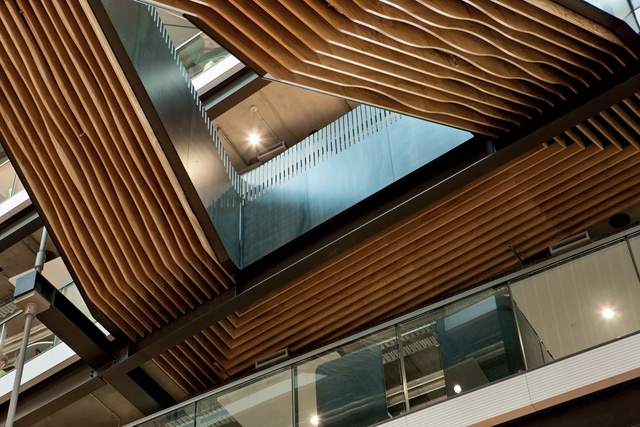
The third value, the sky or ambition theme, is represented by the blue glass ‘lantern’ on the north-west corner of the building. “This is the lens where Fonterra looks out on the world and the world looks in on Fonterra,” says Bryant. “We have played with the floor levels, in order to create something different from the typical office environment, thus encouraging innovative thought.”
The colour scheme derives from the three themes, with land, sky and water tones used for wayfinding around the premises. The overall aesthetic comes from a natural and agricultural palette, incorporating brighter colours in areas where collaboration and activity occurs, and more subdued tones in the focused work areas. Connections to Fonterra’s manufacturing bases can be seen through the exposed services and ductwork on the outside of the building.
“The materiality is of the land, with unpainted timbers and concrete. This is about being proud of the company’s industrial and agricultural roots,” says Bryant.
WORKING WITH ABW
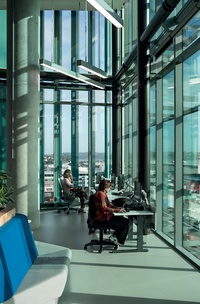
Rather than throw staff into the new workplace unprepared, Fonterra carried out a good deal of training, says Ben Coleman. “We engaged Jasmax in the project from its conception phase in 2012, and they designed an ABW pilot site, dubbed an Experience Centre, where more than 400 of our employees had the opportunity to work for a period of time, to experience the new way of working.”
While there are ‘neighbourhoods’ allocated to each of the departments working at Fonterra, employees are empowered to roam between floors and use any workspace they see fit for the type of work they are doing. There are seven types of work settings, to provide for levels of concentration and collaboration – from independent focused work, through to dual work, casual chat settings, and traditional formal meeting rooms.
Coleman offers an example of the success of ABW for the company: “Say I have done some focused work and then I am encouraged to clear my desk and move; I have found that I am bumping into people who I had booked a meeting room with later in the day, and I’m having that conversation with them and I’m able to cancel that meeting. It clears my diary. With mobility comes much more efficiency. Staff can move around floors, they are using their legs and they are having discussions; then they have more time to carry on with other work.”
ENVIRONMENTAL FACTORS
Wellness, water use and ecology all came into play in the design, which encompasses planting, solar systems and rainwater tanks.
Aside from the ‘follow-me’ systems described below, Fonterra also wanted to also ensure the building was working hard for the environment in other ways, says Jasmax Project Director Tim Hooson. “Goodman (the building developer) did the base build and they have a strong stand on the relationship of their buildings with the environment. Fonterra is in an industry that is being challenged environmentally, and it wanted best practice for all green systems – and to go the extra mile too.”
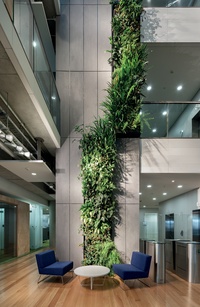
By promoting stair use, there is less energy wasted, as well as encouraging an active lifestyle for staff. Internal and external planting up the walls of the building promotes psychological well-being, whilst also helping to clear the air of Co².
“Fonterra wanted to provide showers and lockers to help staff who wanted to exercise, but this requires a lot of hot water,” explains Hooson. “Solar hot-water systems on the roof provide for 70% of the hot water needs of the building. There are also rainwater recovery tanks on the roof that flush the toilets and irrigate the plants.”
The plaza outside the main entrance to the building was designed to provide a space for staff to step out and have a breath of fresh air. It is also WiFi enabled to allow the staff an option of another working environment outside of the building. The planting in the plaza acts as stormwater filtration, cleaning the water that flows off the building and surrounds when it rains, before it enters the harbour.
TECHNOLOGY AND ABW
In a six-storey building where employees are free to work wherever they see fit, how do you find someone when you need to talk face to face? The Fonterra headquarters uses ‘Find Me’ touchscreen panels, interspaced throughout each floor of the building. By searching the name of the person you wish to find, the system shows the floor and area they are working in, using a three-dimensional GPS system based on the location of that staff member’s laptop.
However, Hooson explains staff members can ‘cloak’ themselves if they want privacy or would like to work uninterrupted. “ABW is based around the idea that you are empowered to decide how and where you are best to work. However, we also had to make sure the building could respond to a population that was moving within it at any one time. Lighting, air conditioning, heating, ventilation – all are able to detect and follow the population of the people in the building effectively, through a combination of movement, CO² and temperature sensors.”
Lockers are provided on each floor, so staff members don’t have to carry everything with them as they move about. Rather than have assigned lockers, Fonterra decided to use the same security cards to open a locker as those used to access the working floors. The same card is also used for printers.
The Fonterra Headquarters won the Workplace over 1,000m2 Award at the 2016 Interior Awards.

